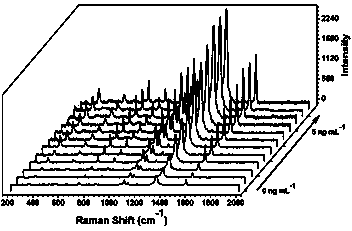Construction method of ultra-sensitive surface-enhanced Raman spectrum (SERS) sensor for measuring Hg<2+>
A surface-enhanced Raman and spectral sensor technology, applied in the field of nano-biotechnology detection, can solve problems such as expensive, complex and time-consuming, and limited universal application.
- Summary
- Abstract
- Description
- Claims
- Application Information
AI Technical Summary
Problems solved by technology
Method used
Image
Examples
Embodiment 1
[0020] A measure of Hg 2+ The construction method of ultrasensitive surface-enhanced Raman spectroscopy sensor, 15nm gold nanoparticles were used to capture Hg 2+ Sequence modification of two aptamers, AuNPs in Hg 2+ Assemble into a chain structure under the condition of existence, and the chain structure of gold nanoparticles is determined by surface-enhanced Raman spectroscopy (SERS); the specific steps are:
[0021] (1) 15nm gold nanoparticles were used to capture Hg 2+ The two aptamer sequence modification :
[0022] The newly synthesized 15nm gold nanoparticles were concentrated tenfold by centrifugation at 10,000r / min, and then resuspended in 0.01 M Tris-HCl buffer to a final concentration of 20nM for DNA Coupling of DNA; DNA coupling was performed in a 100 μL reaction system, 2 μL of 4 μM DNA1 and DNA2 were added to 100 μL of 20 nM gold nanoparticle solution, so that the final concentration of DNA was 80 nM, DNA and gold nanoparticles at 4 : 1 molar ratio for coupl...
PUM
 Login to View More
Login to View More Abstract
Description
Claims
Application Information
 Login to View More
Login to View More - R&D
- Intellectual Property
- Life Sciences
- Materials
- Tech Scout
- Unparalleled Data Quality
- Higher Quality Content
- 60% Fewer Hallucinations
Browse by: Latest US Patents, China's latest patents, Technical Efficacy Thesaurus, Application Domain, Technology Topic, Popular Technical Reports.
© 2025 PatSnap. All rights reserved.Legal|Privacy policy|Modern Slavery Act Transparency Statement|Sitemap|About US| Contact US: help@patsnap.com


